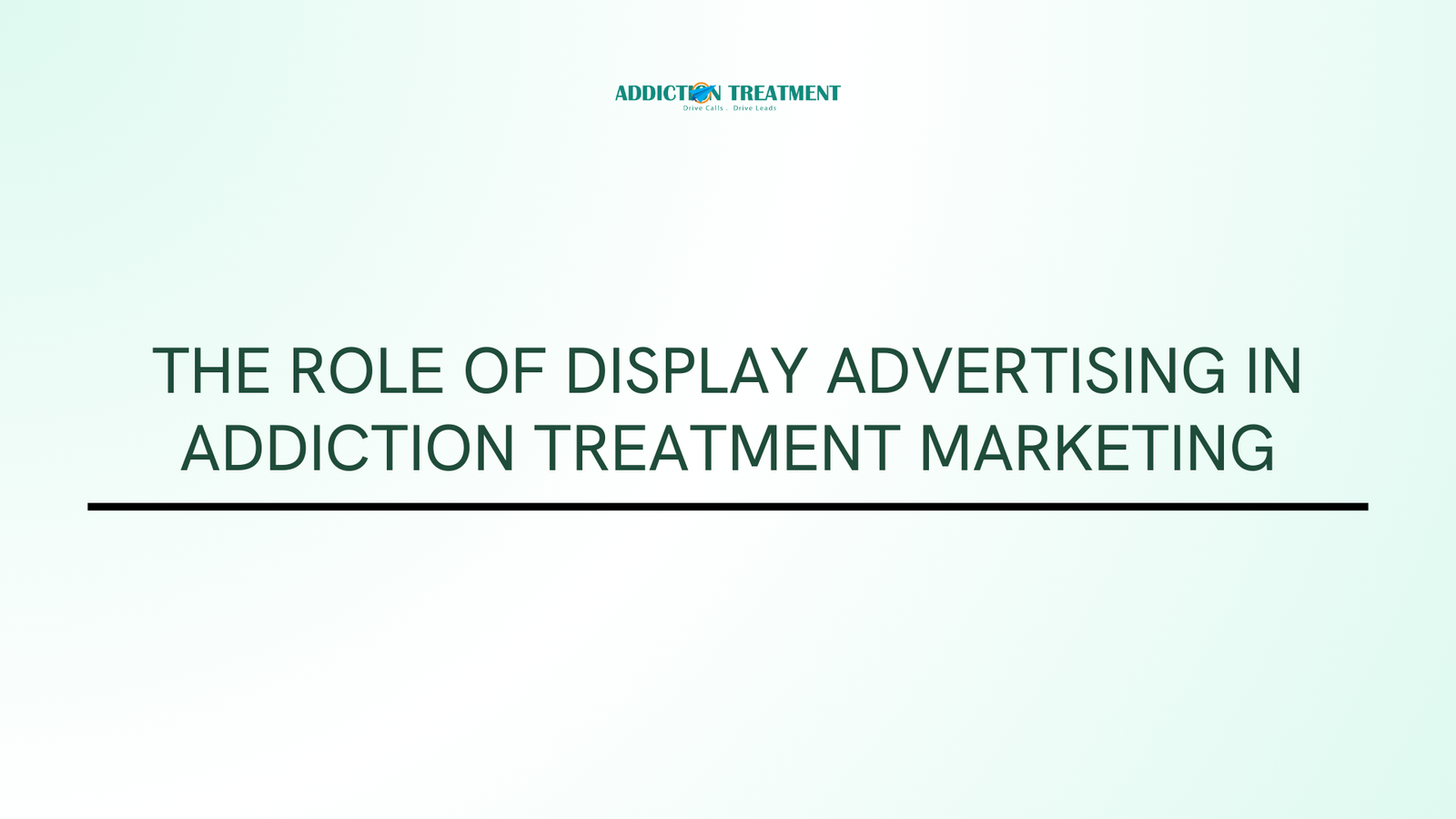Display advertising is a vital component of digital marketing strategies, particularly for addiction treatment centers looking to reach potential patients and their families. Unlike search ads that rely on user intent, display ads focus on visual engagement, brand awareness, and targeted outreach across websites and apps. These ads can help treatment centers educate audiences, build trust, and drive inquiries.
In this article, we’ll explore the role of display advertising in addiction treatment marketing, its benefits, and how to create campaigns that resonate with your target audience while maintaining compliance and sensitivity.
What Is Display Advertising?
Display advertising involves placing visually appealing ads, such as banners, images, and videos, on third-party websites, apps, or platforms. These ads are typically part of a broader network, such as Google Display Network or Microsoft Advertising, allowing businesses to reach large and diverse audiences.
Why Display Advertising Matters for Addiction Treatment Marketing
1. Expanding Reach
Display advertising helps addiction treatment centers reach audiences who may not actively search for treatment but could benefit from seeing relevant information.
- Awareness Generation: Display ads introduce your services to people who might not have considered treatment options.
- Targeting Passive Audiences: These ads can target users based on their browsing behavior, interests, and demographics.
2. Visual Storytelling
The visual nature of display ads makes them effective at evoking emotions and capturing attention.
- Imagery: Photos of serene facilities, caring staff, or happy, healthy individuals can create a powerful impact.
- Videos: Short videos explaining the recovery process or featuring success stories are highly engaging.
3. Retargeting Opportunities
Display ads are excellent for retargeting users who have interacted with your website or ads but didn’t convert.
- Encouraging Re-Engagement: Remind visitors of your services and guide them back to your site.
- Personalized Messaging: Tailor retargeting ads based on user behavior, such as browsing specific programs.
Benefits of Display Advertising for Addiction Treatment Centers
1. Increased Brand Visibility
Display ads appear across various websites, increasing the visibility of your treatment center and making it easier for potential patients to recognize your brand.
2. Precise Targeting
Display networks allow you to target audiences based on:
- Demographics: Age, gender, location, and language.
- Interests: Topics like mental health, addiction recovery, or wellness.
- Behavioral Data: Previous searches or visits to relevant websites.
3. Cost-Effective Campaigns
Compared to traditional advertising methods, display ads often offer a higher return on investment, especially when campaigns are optimized for performance.
4. Measurable Results
With tools like Google Ads or Facebook Ads Manager, you can track metrics such as impressions, clicks, and conversions to assess campaign effectiveness and make data-driven adjustments.
Key Strategies for Effective Display Advertising in Addiction Treatment Marketing
1. Create Emotionally Resonant Ads
Addiction treatment marketing requires a compassionate and supportive tone. Your ads should:
- Offer Hope: Use messaging that emphasizes recovery and new beginnings.
- Be Non-Judgmental: Avoid language that could be perceived as stigmatizing or blaming.
- Use Positive Imagery: Showcase serene environments, caring staff, or testimonials from successful patients.
2. Leverage Retargeting Campaigns
Retargeting ads are a critical component of display advertising, as they target users who have already shown interest in your services.
- Dynamic Ads: Customize retargeting ads to feature specific programs or services that users previously viewed.
- Frequency Capping: Limit how often users see your ads to avoid overexposure and ad fatigue.
3. Focus on Compliance
Advertising addiction treatment services involves adhering to strict regulations, such as Google’s LegitScript certification and HIPAA compliance.
- LegitScript Certification: Ensure your center is certified to run ads on Google and other platforms.
- Privacy Protection: Avoid using identifiable patient information or making unrealistic claims in your ads.
- Accurate Messaging: Be transparent about your services and avoid guarantees of success.
4. Optimize Landing Pages
Your display ads should direct users to well-designed, relevant landing pages that align with the ad’s message.
- Clear Call-to-Action (CTA): Use CTAs like “Get Help Today” or “Speak with a Specialist.”
- Mobile-Friendly Design: Ensure landing pages load quickly and are easy to navigate on mobile devices.
- Relevant Content: Match the landing page content to the ad, such as providing more details about a specific treatment program.
5. Utilize Geo-Targeting
Geo-targeting allows you to focus on specific regions where your treatment center operates.
- Local Outreach: Target users within a certain radius of your facility.
- Regional Campaigns: Customize messaging to address regional concerns, such as opioid addiction rates in specific states.
6. Incorporate A/B Testing
Test different ad variations to identify what resonates most with your audience.
- Visuals: Experiment with images, videos, or color schemes.
- Messaging: Test different headlines, CTAs, or value propositions.
- Placement: Evaluate performance on various websites or apps within your display network.
Measuring the Success of Display Advertising Campaigns
Tracking and analyzing metrics is essential for optimizing your display ad campaigns. Key performance indicators (KPIs) include:
- Impressions: The number of times your ad is shown.
- Click-Through Rate (CTR): The percentage of users who click on your ad after seeing it.
- Conversion Rate: The percentage of users who complete a desired action, such as filling out a form or calling.
- Cost Per Click (CPC): The average amount you pay for each click on your ad.
- Return on Ad Spend (ROAS): The revenue generated for every dollar spent on ads.
Challenges of Display Advertising in Addiction Treatment Marketing
1. Overcoming Ad Fatigue
Repeated exposure to the same ads can lead to declining engagement.
Solution: Rotate ad creatives frequently and diversify messaging to keep your audience engaged.
2. Addressing Stigma
Addiction is a sensitive topic, and some users may hesitate to click on ads due to stigma.
Solution: Use empathetic messaging and focus on providing hope and support.
3. Compliance and Restrictions
Navigating the regulatory landscape for addiction treatment ads can be challenging.
Solution: Work with marketing professionals experienced in healthcare and addiction treatment advertising to ensure compliance.
Future Trends in Display Advertising for Addiction Treatment
As technology and user behavior evolve, new trends are shaping the future of display advertising:
- Programmatic Advertising: Automated ad buying allows for real-time optimization and more precise targeting.
- Interactive Ads: Ads featuring polls, quizzes, or videos can drive higher engagement.
- Artificial Intelligence: AI tools can analyze user behavior and deliver personalized ads for improved performance.
Conclusion
Display advertising plays a critical role in addiction treatment marketing by raising awareness, engaging audiences, and driving inquiries. By creating empathetic, visually compelling ads and leveraging targeting and retargeting strategies, treatment centers can effectively connect with potential patients and their families. With a focus on compliance, optimization, and measurable results, display ads can become a cornerstone of your digital marketing strategy.


Leave a Reply